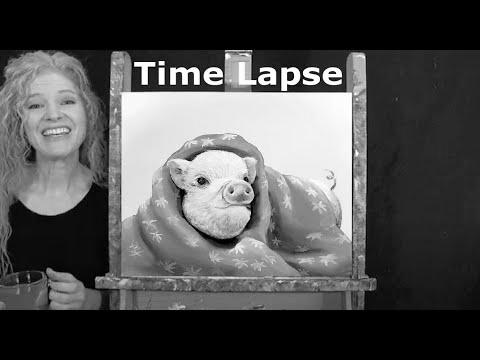TIME LAPSE – Study Easy methods to Paint "PIG IN A BLANKET" with Acrylic Paint- Step by Step Video Tutorial
Warning: Undefined variable $post_id in /home/webpages/lima-city/booktips/wordpress_de-2022-03-17-33f52d/wp-content/themes/fast-press/single.php on line 26

Study , TIME LAPSE - Study The right way to Paint "PIG IN A BLANKET" with Acrylic Paint- Step by Step Video Tutorial , , aBmAJDoY1Dk , https://www.youtube.com/watch?v=aBmAJDoY1Dk , https://i.ytimg.com/vi/aBmAJDoY1Dk/hqdefault.jpg , 4842 , 5.00 , PAINTING VIDEO DESCRIPTION – It is a time lapsed version on the best way to paint this cute animal portrait image of "PIG IN A ... , 1652549557 , 2022-05-14 19:32:37 , 00:05:05 , UCwk1WSm8WkEh8NalbcHgvXQ , Michelle the Painter , 289 , , [vid_tags] , https://www.youtubepp.com/watch?v=aBmAJDoY1Dk , [ad_2] , [ad_1] , https://www.youtube.com/watch?v=aBmAJDoY1Dk, #TIME #LAPSE #Study #Paint #quotPIG #BLANKETquot #Acrylic #Paint #Step #Step #Video #Tutorial [publish_date]
#TIME #LAPSE #Be taught #Paint #quotPIG #BLANKETquot #Acrylic #Paint #Step #Step #Video #Tutorial
PAINTING VIDEO DESCRIPTION – It is a time lapsed version on the best way to paint this cute animal portrait picture of "PIG IN A ...
Quelle: [source_domain]
- Mehr zu learn Learning is the activity of effort new understanding, cognition, behaviors, skills, values, attitudes, and preferences.[1] The ability to learn is possessed by human, animals, and some machinery; there is also bear witness for some kinda encyclopaedism in certain plants.[2] Some encyclopedism is proximate, spontaneous by a separate event (e.g. being baked by a hot stove), but much skill and cognition put in from continual experiences.[3] The changes evoked by encyclopaedism often last a lifetime, and it is hard to characterize knowledgeable fabric that seems to be "lost" from that which cannot be retrieved.[4] Human encyclopaedism launch at birth (it might even start before[5] in terms of an embryo's need for both fundamental interaction with, and exemption within its state of affairs within the womb.[6]) and continues until death as a outcome of on-going interactions between fans and their state of affairs. The existence and processes caught up in education are unstudied in many established comedian (including educational psychological science, psychology, psychonomics, psychological feature sciences, and pedagogy), likewise as emergent fields of noesis (e.g. with a common refer in the topic of education from device events such as incidents/accidents,[7] or in cooperative encyclopaedism wellbeing systems[8]). Investigating in such comic has led to the identity of varied sorts of encyclopaedism. For good example, education may occur as a effect of dependency, or conditioning, conditioning or as a effect of more convoluted activities such as play, seen only in relatively intelligent animals.[9][10] Encyclopedism may occur unconsciously or without conscious incognizance. Encyclopaedism that an aversive event can't be avoided or loose may outcome in a condition named well-educated helplessness.[11] There is info for human behavioural encyclopaedism prenatally, in which addiction has been determined as early as 32 weeks into physiological state, indicating that the fundamental nervous organization is insufficiently formed and set for eruditeness and faculty to occur very early in development.[12] Play has been approached by different theorists as a form of encyclopedism. Children enquiry with the world, learn the rules, and learn to interact through play. Lev Vygotsky agrees that play is pivotal for children's development, since they make meaning of their environs through performing arts educational games. For Vygotsky, yet, play is the first form of eruditeness language and human activity, and the stage where a child begins to understand rules and symbols.[13] This has led to a view that encyclopedism in organisms is e'er accompanying to semiosis,[14] and often joint with nonrepresentational systems/activity.
Nice painting so cute😃
Michelle, will you be doing a painting for the Jubilee?
Can u paint a snow landscape with a detailed snowflake 😅
So cute!❣️🐷
Oh!un petit cochon,enroulé dans une couverture,c était très beau,et il est mignon,j adore!😀
It's wonderful your painting
✅♥
Espectacular trabajo!!!
Fascinante!!!
Gorgeous …❤❤❤ gooooood job!! Hope one day we paint together.
Adorable! Put an INSTANT smile on my face.
So very cute, as well as everything you do. So gifted, I watch every one I can.
You are quite versatile ! Love it… !
How would I do this if I wanted the pig to be black?
Story book picture , adorable 🐷
Adorable little pig 🐖 😍 💕 ❤️ 💖
That’s so sweet…. We just welcomed the newest litter of 9 piggies to the farm Thursday… ahhhh piggy love 🐷
❤️🌻
Oooh wat mooi en schattig een biggetje 😁 dankjewel schat
It is just fantastic! Great use of color.
This is really ingenious Michelle. A sure thing to bring a smile to the face 😍
ΥΟU ARE GREAT..
🥰🥰🥰💕💕💕❣️❣️
Oh too cute 😊👏👏👏
Adorei!!!👏🏻👏🏻
Very cute